机器学习作业(六)支持向量机——Matlab实现
题目下载【传送门】
第1题
简述:支持向量机的实现
(1)线性的情况:
第1步:读取数据文件,可视化数据:
- % Load from ex6data1:
- % You will have X, y in your environment
- load('ex6data1.mat');
- % Plot training data
- plotData(X, y);
第2步:设定不同的C,使用线性核函数训练SVM,并画出决策边界:
- C = 1;
- model = svmTrain(X, y, C, @linearKernel, 1e-3, 20);
- visualizeBoundaryLinear(X, y, model);
运行结果:
C = 1时:
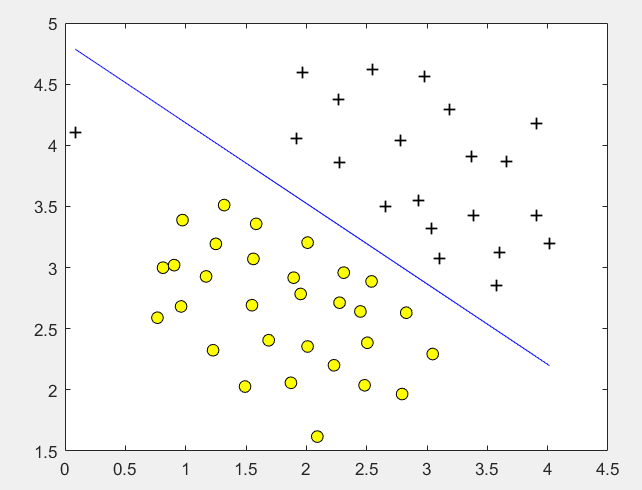
C = 1000时:
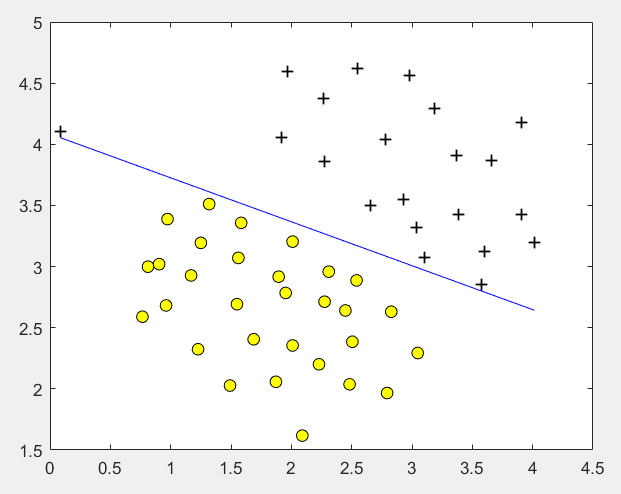
其中线性核函数linearKernel:
- function sim = linearKernel(x1, x2)
- % Ensure that x1 and x2 are column vectors
- x1 = x1(:); x2 = x2(:);
- % Compute the kernel
- sim = x1' * x2; % dot product
- end
高斯核函数gaussianKernel实现:
- function sim = gaussianKernel(x1, x2, sigma)
- % Ensure that x1 and x2 are column vectors
- x1 = x1(:); x2 = x2(:);
- % You need to return the following variables correctly.
- sim = 0;
- sim = exp(-norm(x1 - x2) ^ 2 / (2 * (sigma ^ 2)));
- end
训练模型svmTrain函数(实现较为复杂,直接调用):
- function [model] = svmTrain(X, Y, C, kernelFunction, ...
- tol, max_passes)
- %SVMTRAIN Trains an SVM classifier using a simplified version of the SMO
- %algorithm.
- % [model] = SVMTRAIN(X, Y, C, kernelFunction, tol, max_passes) trains an
- % SVM classifier and returns trained model. X is the matrix of training
- % examples. Each row is a training example, and the jth column holds the
- % jth feature. Y is a column matrix containing 1 for positive examples
- % and 0 for negative examples. C is the standard SVM regularization
- % parameter. tol is a tolerance value used for determining equality of
- % floating point numbers. max_passes controls the number of iterations
- % over the dataset (without changes to alpha) before the algorithm quits.
- %
- % Note: This is a simplified version of the SMO algorithm for training
- % SVMs. In practice, if you want to train an SVM classifier, we
- % recommend using an optimized package such as:
- %
- % LIBSVM (http://www.csie.ntu.edu.tw/~cjlin/libsvm/)
- % SVMLight (http://svmlight.joachims.org/)
- %
- %
- if ~exist('tol', 'var') || isempty(tol)
- tol = 1e-3;
- end
- if ~exist('max_passes', 'var') || isempty(max_passes)
- max_passes = 5;
- end
- % Data parameters
- m = size(X, 1);
- n = size(X, 2);
- % Map 0 to -1
- Y(Y==0) = -1;
- % Variables
- alphas = zeros(m, 1);
- b = 0;
- E = zeros(m, 1);
- passes = 0;
- eta = 0;
- L = 0;
- H = 0;
- % Pre-compute the Kernel Matrix since our dataset is small
- % (in practice, optimized SVM packages that handle large datasets
- % gracefully will _not_ do this)
- %
- % We have implemented optimized vectorized version of the Kernels here so
- % that the svm training will run faster.
- if strcmp(func2str(kernelFunction), 'linearKernel')
- % Vectorized computation for the Linear Kernel
- % This is equivalent to computing the kernel on every pair of examples
- K = X*X';
- elseif strfind(func2str(kernelFunction), 'gaussianKernel')
- % Vectorized RBF Kernel
- % This is equivalent to computing the kernel on every pair of examples
- X2 = sum(X.^2, 2);
- K = bsxfun(@plus, X2, bsxfun(@plus, X2', - 2 * (X * X')));
- K = kernelFunction(1, 0) .^ K;
- else
- % Pre-compute the Kernel Matrix
- % The following can be slow due to the lack of vectorization
- K = zeros(m);
- for i = 1:m
- for j = i:m
- K(i,j) = kernelFunction(X(i,:)', X(j,:)');
- K(j,i) = K(i,j); %the matrix is symmetric
- end
- end
- end
- % Train
- fprintf('\nTraining ...');
- dots = 12;
- while passes < max_passes,
- num_changed_alphas = 0;
- for i = 1:m,
- % Calculate Ei = f(x(i)) - y(i) using (2).
- % E(i) = b + sum (X(i, :) * (repmat(alphas.*Y,1,n).*X)') - Y(i);
- E(i) = b + sum (alphas.*Y.*K(:,i)) - Y(i);
- if ((Y(i)*E(i) < -tol && alphas(i) < C) || (Y(i)*E(i) > tol && alphas(i) > 0)),
- % In practice, there are many heuristics one can use to select
- % the i and j. In this simplified code, we select them randomly.
- j = ceil(m * rand());
- while j == i, % Make sure i \neq j
- j = ceil(m * rand());
- end
- % Calculate Ej = f(x(j)) - y(j) using (2).
- E(j) = b + sum (alphas.*Y.*K(:,j)) - Y(j);
- % Save old alphas
- alpha_i_old = alphas(i);
- alpha_j_old = alphas(j);
- % Compute L and H by (10) or (11).
- if (Y(i) == Y(j)),
- L = max(0, alphas(j) + alphas(i) - C);
- H = min(C, alphas(j) + alphas(i));
- else
- L = max(0, alphas(j) - alphas(i));
- H = min(C, C + alphas(j) - alphas(i));
- end
- if (L == H),
- % continue to next i.
- continue;
- end
- % Compute eta by (14).
- eta = 2 * K(i,j) - K(i,i) - K(j,j);
- if (eta >= 0),
- % continue to next i.
- continue;
- end
- % Compute and clip new value for alpha j using (12) and (15).
- alphas(j) = alphas(j) - (Y(j) * (E(i) - E(j))) / eta;
- % Clip
- alphas(j) = min (H, alphas(j));
- alphas(j) = max (L, alphas(j));
- % Check if change in alpha is significant
- if (abs(alphas(j) - alpha_j_old) < tol),
- % continue to next i.
- % replace anyway
- alphas(j) = alpha_j_old;
- continue;
- end
- % Determine value for alpha i using (16).
- alphas(i) = alphas(i) + Y(i)*Y(j)*(alpha_j_old - alphas(j));
- % Compute b1 and b2 using (17) and (18) respectively.
- b1 = b - E(i) ...
- - Y(i) * (alphas(i) - alpha_i_old) * K(i,j)' ...
- - Y(j) * (alphas(j) - alpha_j_old) * K(i,j)';
- b2 = b - E(j) ...
- - Y(i) * (alphas(i) - alpha_i_old) * K(i,j)' ...
- - Y(j) * (alphas(j) - alpha_j_old) * K(j,j)';
- % Compute b by (19).
- if (0 < alphas(i) && alphas(i) < C),
- b = b1;
- elseif (0 < alphas(j) && alphas(j) < C),
- b = b2;
- else
- b = (b1+b2)/2;
- end
- num_changed_alphas = num_changed_alphas + 1;
- end
- end
- if (num_changed_alphas == 0),
- passes = passes + 1;
- else
- passes = 0;
- end
- fprintf('.');
- dots = dots + 1;
- if dots > 78
- dots = 0;
- fprintf('\n');
- end
- if exist('OCTAVE_VERSION')
- fflush(stdout);
- end
- end
- fprintf(' Done! \n\n');
- % Save the model
- idx = alphas > 0;
- model.X= X(idx,:);
- model.y= Y(idx);
- model.kernelFunction = kernelFunction;
- model.b= b;
- model.alphas= alphas(idx);
- model.w = ((alphas.*Y)'*X)';
- end
(2)非线性的情况:
第1步:读取数据文件,并可视化数据:
- % Load from ex6data2:
- % You will have X, y in your environment
- load('ex6data2.mat');
- % Plot training data
- plotData(X, y);
第2步:使用高斯核函数进行训练:
- % SVM Parameters
- C = 1; sigma = 0.1;
- % We set the tolerance and max_passes lower here so that the code will run
- % faster. However, in practice, you will want to run the training to
- % convergence.
- model= svmTrain(X, y, C, @(x1, x2) gaussianKernel(x1, x2, sigma));
- visualizeBoundary(X, y, model);
运行结果:
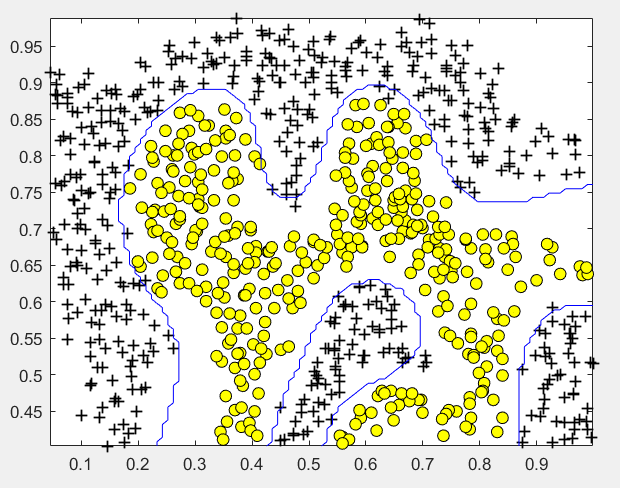
(3)非线性情况2:
第1步:读取数据文件,并可视化数据:
- % Load from ex6data3:
- % You will have X, y in your environment
- load('ex6data3.mat');
- % Plot training data
- plotData(X, y);
第2步:尝试不同的参数,选取准确率最高的:
- % Try different SVM Parameters here
- [C, sigma] = dataset3Params(X, y, Xval, yval);
- % Train the SVM
- model= svmTrain(X, y, C, @(x1, x2) gaussianKernel(x1, x2, sigma));
- visualizeBoundary(X, y, model);
其中datasetParams函数:
- function [C, sigma] = dataset3Params(X, y, Xval, yval)
- % You need to return the following variables correctly.
- C = 1;
- sigma = 0.3;
- C_vec = [0.01, 0.03, 0.1, 0.3, 1, 3, 10, 30];
- sigma_vec = [0.01, 0.03, 0.1, 0.3, 1, 3, 10, 30];
- m = size(C_vec, 2);
- error_val = 1;
- for i = 1:m
- for j = 1:m
- model= svmTrain(X, y, C_vec(i), @(x1, x2) gaussianKernel(x1, x2, sigma_vec(j)));
- pred = svmPredict(model, Xval);
- error_temp = mean(double(pred ~= yval));
- if error_temp < error_val
- C = C_vec(i);
- sigma = sigma_vec(j);
- error_val = error_temp;
- end
- end
- end
- end
其中svmPredict函数:
- function pred = svmPredict(model, X)
- % Check if we are getting a column vector, if so, then assume that we only
- % need to do prediction for a single example
- if (size(X, 2) == 1)
- % Examples should be in rows
- X = X';
- end
- % Dataset
- m = size(X, 1);
- p = zeros(m, 1);
- pred = zeros(m, 1);
- if strcmp(func2str(model.kernelFunction), 'linearKernel')
- % We can use the weights and bias directly if working with the
- % linear kernel
- p = X * model.w + model.b;
- elseif strfind(func2str(model.kernelFunction), 'gaussianKernel')
- % Vectorized RBF Kernel
- % This is equivalent to computing the kernel on every pair of examples
- X1 = sum(X.^2, 2);
- X2 = sum(model.X.^2, 2)';
- K = bsxfun(@plus, X1, bsxfun(@plus, X2, - 2 * X * model.X'));
- K = model.kernelFunction(1, 0) .^ K;
- K = bsxfun(@times, model.y', K);
- K = bsxfun(@times, model.alphas', K);
- p = sum(K, 2);
- else
- % Other Non-linear kernel
- for i = 1:m
- prediction = 0;
- for j = 1:size(model.X, 1)
- prediction = prediction + ...
- model.alphas(j) * model.y(j) * ...
- model.kernelFunction(X(i,:)', model.X(j,:)');
- end
- p(i) = prediction + model.b;
- end
- end
- % Convert predictions into 0 / 1
- pred(p >= 0) = 1;
- pred(p < 0) = 0;
- end
运行结果:
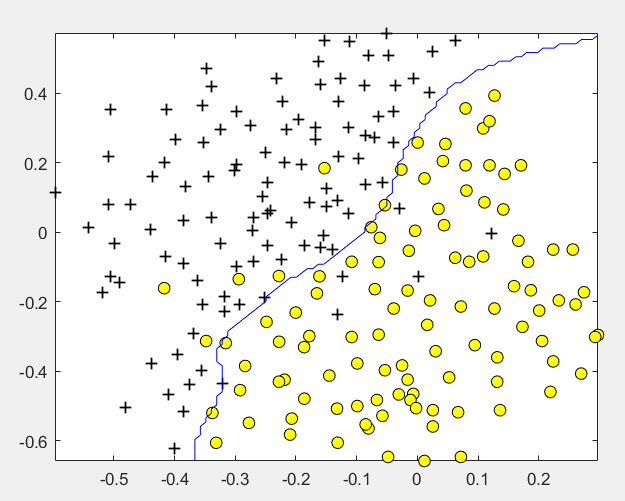
第2题
概述:实现垃圾邮件的识别
第1步:读取数据文件,对单词进行处理:
- % Extract Features
- file_contents = readFile('emailSample1.txt');
- word_indices = processEmail(file_contents);
- % Print Stats
- fprintf('Word Indices: \n');
- fprintf(' %d', word_indices);
- fprintf('\n\n');
单词处理过程:
去除符号、空格、换行等;
识别出邮箱、价格、超链接、数字,替换为特定单词;
在关键词列表中找出出现的关键词,并标记为出单词编号.
- function word_indices = processEmail(email_contents)
- % Load Vocabulary
- vocabList = getVocabList();
- % Init return value
- word_indices = [];
- % ========================== Preprocess Email ===========================
- % Find the Headers ( \n\n and remove )
- % Uncomment the following lines if you are working with raw emails with the
- % full headers
- % hdrstart = strfind(email_contents, ([char(10) char(10)]));
- % email_contents = email_contents(hdrstart(1):end);
- % Lower case
- email_contents = lower(email_contents);
- % Strip all HTML
- % Looks for any expression that starts with < and ends with > and replace
- % and does not have any < or > in the tag it with a space
- email_contents = regexprep(email_contents, '<[^<>]+>', ' ');
- % Handle Numbers
- % Look for one or more characters between 0-9
- email_contents = regexprep(email_contents, '[0-9]+', 'number');
- % Handle URLS
- % Look for strings starting with http:// or https://
- email_contents = regexprep(email_contents, ...
- '(http|https)://[^\s]*', 'httpaddr');
- % Handle Email Addresses
- % Look for strings with @ in the middle
- email_contents = regexprep(email_contents, '[^\s]+@[^\s]+', 'emailaddr');
- % Handle $ sign
- email_contents = regexprep(email_contents, '[$]+', 'dollar');
- % ========================== Tokenize Email ===========================
- % Output the email to screen as well
- fprintf('\n==== Processed Email ====\n\n');
- % Process file
- l = 0;
- while ~isempty(email_contents)
- % Tokenize and also get rid of any punctuation
- [str, email_contents] = ...
- strtok(email_contents, ...
- [' @$/#.-:&*+=[]?!(){},''">_<;%' char(10) char(13)]);
- % Remove any non alphanumeric characters
- str = regexprep(str, '[^a-zA-Z0-9]', '');
- % Stem the word
- % (the porterStemmer sometimes has issues, so we use a try catch block)
- try str = porterStemmer(strtrim(str));
- catch str = ''; continue;
- end;
- % Skip the word if it is too short
- if length(str) < 1
- continue;
- end
- for i = 1:size(vocabList),
- if strcmp(str, vocabList(i)),
- word_indices = [word_indices i];
- end
- end
- % Print to screen, ensuring that the output lines are not too long
- if (l + length(str) + 1) > 78
- fprintf('\n');
- l = 0;
- end
- fprintf('%s ', str);
- l = l + length(str) + 1;
- end
- % Print footer
- fprintf('\n\n=========================\n');
- end
其中读取关键字列表函数:
- function vocabList = getVocabList()
- %% Read the fixed vocabulary list
- fid = fopen('vocab.txt');
- % Store all dictionary words in cell array vocab{}
- n = 1899; % Total number of words in the dictionary
- % For ease of implementation, we use a struct to map the strings => integers
- % In practice, you'll want to use some form of hashmap
- vocabList = cell(n, 1);
- for i = 1:n
- % Word Index (can ignore since it will be = i)
- fscanf(fid, '%d', 1);
- % Actual Word
- vocabList{i} = fscanf(fid, '%s', 1);
- end
- fclose(fid);
- end
第3步:对关键字进行特征值标记,出现的关键词标记为1:
- % Extract Features
- features = emailFeatures(word_indices);
- % Print Stats
- fprintf('Length of feature vector: %d\n', length(features));
- fprintf('Number of non-zero entries: %d\n', sum(features > 0));
其中emailFeatures函数为:
- function x = emailFeatures(word_indices)
- % Total number of words in the dictionary
- n = 1899;
- % You need to return the following variables correctly.
- x = zeros(n, 1);
- for i = 1:size(word_indices),
- x(word_indices(i)) = 1;
- end
- end
第4步:使用线性核函数进行训练,并分别计算训练集准确率和测试集准确率:
- % Load the Spam Email dataset
- % You will have X, y in your environment
- load('spamTrain.mat');
- fprintf('\nTraining Linear SVM (Spam Classification)\n')
- fprintf('(this may take 1 to 2 minutes) ...\n')
- C = 0.1;
- model = svmTrain(X, y, C, @linearKernel);
- p = svmPredict(model, X);
- fprintf('Training Accuracy: %f\n', mean(double(p == y)) * 100);
- % Load the test dataset
- % You will have Xtest, ytest in your environment
- load('spamTest.mat');
- fprintf('\nEvaluating the trained Linear SVM on a test set ...\n')
- p = svmPredict(model, Xtest);
- fprintf('Test Accuracy: %f\n', mean(double(p == ytest)) * 100);
运行结果:

第5步:找出最高权重的关键词:
- % Sort the weights and obtin the vocabulary list
- [weight, idx] = sort(model.w, 'descend');
- vocabList = getVocabList();
- fprintf('\nTop predictors of spam: \n');
- for i = 1:15
- fprintf(' %-15s (%f) \n', vocabList{idx(i)}, weight(i));
- end
- fprintf('\n\n');
- fprintf('\nProgram paused. Press enter to continue.\n');
- pause;
运行结果:
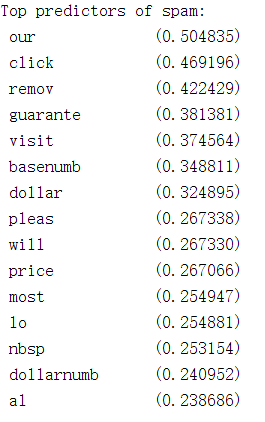
机器学习作业(六)支持向量机——Matlab实现的更多相关文章
- Coursera公开课笔记: 斯坦福大学机器学习第六课“逻辑回归(Logistic Regression)” 清晰讲解logistic-good!!!!!!
原文:http://52opencourse.com/125/coursera%E5%85%AC%E5%BC%80%E8%AF%BE%E7%AC%94%E8%AE%B0-%E6%96%AF%E5%9D ...
- 機器學習基石(Machine Learning Foundations) 机器学习基石 作业四 Q13-20 MATLAB实现
大家好,我是Mac Jiang,今天和大家分享Coursera-NTU-機器學習基石(Machine Learning Foundations)-作业四 Q13-20的MATLAB实现. 曾经的代码都 ...
- 机器学习作业(八)异常检测与推荐系统——Matlab实现
题目下载[传送门] 第1题 简述:对于一组网络数据进行异常检测. 第1步:读取数据文件,使用高斯分布计算 μ 和 σ²: % The following command loads the datas ...
- 机器学习作业(七)非监督学习——Matlab实现
题目下载[传送门] 第1题 简述:实现K-means聚类,并应用到图像压缩上. 第1步:实现kMeansInitCentroids函数,初始化聚类中心: function centroids = kM ...
- 机器学习作业(五)机器学习算法的选择与优化——Matlab实现
题目下载[传送门] 第1步:读取数据文件,并可视化: % Load from ex5data1: % You will have X, y, Xval, yval, Xtest, ytest in y ...
- 机器学习作业(四)神经网络参数的拟合——Matlab实现
题目下载[传送门] 题目简述:识别图片中的数字,训练该模型,求参数θ. 第1步:读取数据文件: %% Setup the parameters you will use for this exerci ...
- 机器学习作业(三)多类别分类与神经网络——Matlab实现
题目太长了!下载地址[传送门] 第1题 简述:识别图片上的数字. 第1步:读取数据文件: %% Setup the parameters you will use for this part of t ...
- 机器学习作业(二)逻辑回归——Matlab实现
题目太长啦!文档下载[传送门] 第1题 简述:实现逻辑回归. 第1步:加载数据文件: data = load('ex2data1.txt'); X = data(:, [1, 2]); y = dat ...
- 机器学习作业(一)线性回归——Matlab实现
题目太长啦!文档下载[传送门] 第1题 简述:设计一个5*5的单位矩阵. function A = warmUpExercise() A = []; A = eye(5); end 运行结果: 第2题 ...
随机推荐
- vue 使用v-for进行循环
<!DOCTYPE html> <html lang="en"> <head> <meta charset="UTF-8&quo ...
- Android.mk文件LOCAL_SDK_VERSION选项
Api分类 internal api 翻译为内部API,理解为供sdk内部使用的API. 这类接口最初打算就是不对外公开的,有点private的意思. hide api 在源码中看到使用@hide 标 ...
- Linux nohup不输出日志文件的方法
引用:https://blog.csdn.net/guotao15285007494/article/details/84136234 最近在Linux上部署视频流推送应用时,由于网络不稳定等原因程序 ...
- java-十进制与十六进制的转化
问题: 在一些特定的情况下,程序中需要用到进制之间的转化,现在来说说十进制和十六进制的转化. 其实java进制转换非常的简单. 那问什么还要说这个问题呢? 因为在转化的时候遇到一个问题... 记录一下 ...
- ggEditor流程图增加网格背景
参考官方文档: https://www.yuque.com/antv/g6/plugin.tool.grid react-ggEditor如何使用 import { Flow } from 'gg-e ...
- CSS字体连写及外观属性
一.font:字体连写 使用font属性时,必须按以下语法格式中的顺序书写,不能更换顺序,各个属性以空格隔开.注意:其中不需要设置的属性可以省略(取默认值),但必须保留font-size和font-f ...
- css基础-float浮动
float实现文字环绕图片效果: <!DOCTYPE html> <html lang="en"> <head> <meta charse ...
- Linux下搭建asp.net运行环境
最近有个项目,是在Windows平台下开发的,需要把 asp.net web应用移植到 CentOS下,甚是头疼: 翻阅资料,发现Jexus是个可行的方案,下面是官方对Jexus的定义: 什么是Jex ...
- 安装 browsercookie 模块详细步骤
在安装browsercookie时遇到了不少问题,现在终于解决了,把方法分享下,希望能帮大家节约点时间 到此网址上下载压缩包: https://pypi.org/project/browsercook ...
- Uva10820 欧拉公式模板(求小于n且与n互素的数的个数)
题意: 给出n,算出小于等于n的所有数中,有几对互质: 解法: 本质就是求有多少个2元组(x,y)满足:1 <= x,y <= n,且x与y互素. 除了(1,1)之外,其他所有的x和y都不 ...
